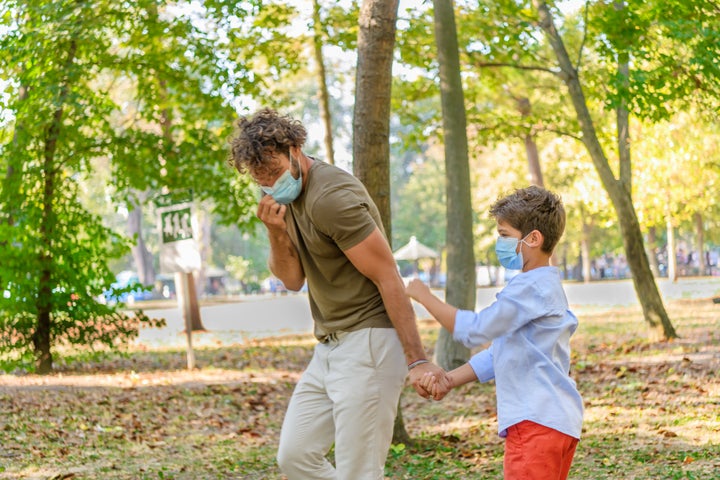Experts give advice for assessing risk as families navigate this next stretch of the COVID-19 pandemic.

Millions of American parents are now either partially or fully vaccinated against COVID-19. But for millions of kids, that prospect is still a long way off.
While many teenagers ages 16 and older are now able to get vaccinated — and new data from Pfizer suggests its vaccine is safe and highly effective in children as young as 12 — we’re likely months away from large swaths of kiddos rolling up their sleeves.
“It’s more likely that the majority of children won’t be vaccinated until the end of this year, or the beginning of next year,” said Steven Abelowitz, a pediatrician with Coastal Kids Pediatrics in Orange County, California. He emphasized, though, that even best guesses are “all speculation” at this point.
That means parents are in for a strange stretch of months when they suddenly have a whole lot more protection, but their kids don’t. Here are some basics to keep in mind as you navigate that new (new new?) normal.
First, know that for kids, nothing has really changed.
It might feel pretty different to be vaccinated yourself, but remember that COVID-19 precautions for kids and other unvaccinated people have not changed over the past few months, Abelowitz said.
Kids should still be protecting themselves by wearing face masks, avoiding crowds and poorly ventilated indoor spaces, and washing their hands — basically everything we’ve been hearing, and hopefully doing, for the past year. One slight change: The Centers for Disease Control and Prevention now says 3 feet of physical distance is sufficient to help prevent the spread of the coronavirus in schools.
But spending time indoors with vaccinated family members is now safe.
One area where there has been some change is federal recommendations around how children are able to interact with fully vaccinated people outside their households.
People who’ve been fully vaccinated can now spend time indoors — and unmasked — with those who haven’t, so long as the unvaccinated individuals (in this case, kids) aren’t at high risk for serious COVID-19 complications, according to the CDC.
That means if your child has a beloved adult in their life who is fully vaccinated, they can go ahead and hang out together indoors without you needing to worry that they’ll contract the virus. (Of course, no one can say there’s no risk, but the risk is low, especially now that the CDC says there’s ample evidence that fully vaccinated people aren’t likely to transmit the virus.)
All of this is probably very welcome news to a lot of grandparents, aunts and uncles and babysitters — and the kids who love them.
Their *mathematical* risk of catching COVID-19 is lower.
To be clear: You being vaccinated does not directly affect your child’s own risk of getting COVID-19 — unless you happen to be breastfeeding, in which case there is mounting evidence that parents who are breastfeeding do, in fact, pass along antibodies.
So if, say, your kids are exposed to COVID-19 at school or someone who is infected coughs on your children during a flight to a family vacation, your vaccination status does nothing to keep them healthy.
That said, when parents or caregivers are vaccinated, it does — in a more roundabout way — influence children’s level of risk.
“What we’ve learned through the vast majority of epidemiological studies is that children were getting infected by their household contacts,” said David Cennimo , a pediatric infectious disease expert at Rutgers New Jersey Medical School. “So if parents are vaccinated, it’s highly unlikely that they’re going to bring COVID home.”
“On a total math equation of ‘how protected are they?’” he continued, “they are much more protected now that you have the vaccine.”
We’re not, however, anywhere near the point where herd immunity would offer them more direct protection.
Want to cut your kid’s risk? Ask about vaccination status.
Planning play dates? Thinking about family trips? Considering camp or extracurriculars? The same basics that have guided risk-benefit analyses so far during the pandemic still apply. Outdoor settings are less risky than indoor settings. Bigger spaces are better than smaller spaces. Being in a small group (or no group at all) is safer than being in a large one.
But one thing has changed: Now you should definitely be asking people about their vaccination status, which can be a tricky conversation to have.
“If I had a child and they were going over for a play date, I’d want to know: Are the adults in that household vaccinated?” Cennimo said. “Because if they are, the likelihood that there is COVID in that household is so much lower.”
Know that if this — any of this — feels difficult to sort through, you’re not alone. There are no easy answers, and parents will continue to have to make decisions that feel right to them.
Parents should also feel empowered to weigh the potential benefits of letting their kids reconnect with friends or simply have fun, Cennimo said. All of these are considerations to keep in mind.
“People need to think about their comfort levels and, within the guidance provided, really titrate their activity to their comfort levels,” he said.
